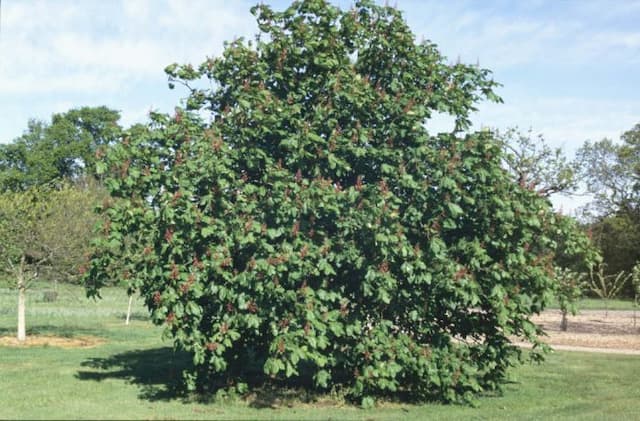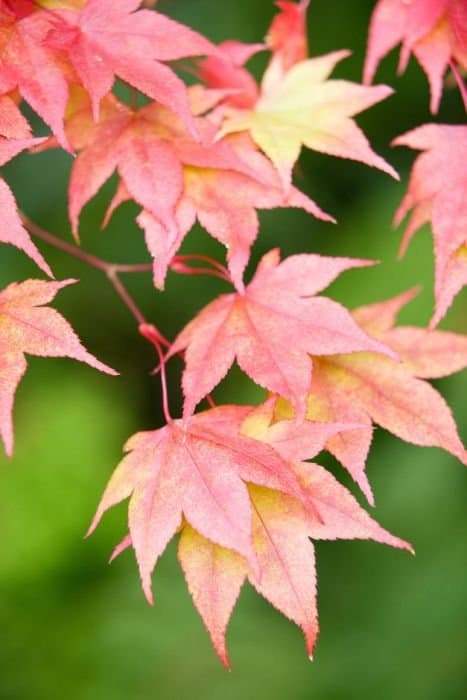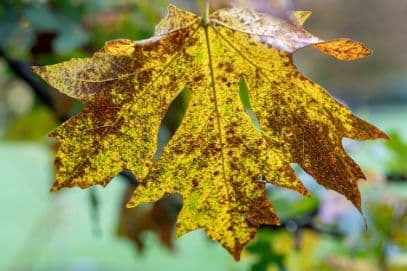Field Maple Acer campestre

ABOUT
The field maple, commonly known as Acer campestre, is a deciduous plant that is native to much of Europe. In appearance, it presents a rounded canopy with dense, lush foliage. The leaves of the field maple are distinctive, with a typical five-lobed shape that is reminiscent of a classic maple leaf. These leaves are small to medium in size, with smooth margins, and they have a rich green color that changes to a yellow or sometimes reddish hue in the autumn. Field maples produce flowers as well, which are yellow-green in color and may not be immediately noticeable as they blend with the foliage. The flowers give way to characteristic winged fruits called samaras, which can be seen spinning to the ground in the wind during the fall. The bark of the plant is grey and becomes furrowed as it matures, giving the stem and branches a textured appearance. It's important to note that while the field maple is adaptable to various soil types and conditions, the color and vibrancy of the leaves can be influenced by the plant's environment, sometimes presenting in more muted tones if not in ideal conditions. The general visual presentation of the field maple contributes to its popularity as a specimen for landscaping, hedgerows, and even bonsai due to its appealing and versatile appearance.
About this plant
 Names
NamesFamily
Sapindaceae
Synonyms
Hedge Maple, Field Maple, Common Maple
Common names
Acer campestre L., Acer campestre var. leiocarpum Opiz, Acer campestre f. microcarpum Schwer., Acer campestre f. palmatifidum Schwer., Acer campestre f. pubescens Aiton, Acer elegans Sm. in Sowerby, Acer macropterum Klokov, Acer opulifolium Gilib., Acer postii Petz. & G.Kirchn., Acer praecox Salisb., Acer rotundifolium Hoffmanns., Acer rufinerve Petz. & G.Kirchn., Acer turkestanicum Pax, Acer worleei Dippel.
 Toxicity
ToxicityTo humans
The Acer campestre, commonly known as the hedge maple, is not widely recognized for having toxic effects on humans. While some parts of maples may cause discomfort if ingested or if the sap comes in contact with the skin, it generally does not cause serious poisoning or life-threatening symptoms.
To pets
The hedge maple (Acer campestre) is generally considered non-toxic to pets. It is not commonly associated with poisoning in domestic animals like cats and dogs. If a pet were to ingest parts of this plant, it is unlikely to lead to serious illness, though monitoring for any signs of gastrointestinal discomfort is advisable as individual sensitivity may vary.
 Characteristics
CharacteristicsLife cycle
Perennials
Foliage type
Deciduous
Color of leaves
Green
Flower color
Yellow-green
Height
35 feet (10.668 meters)
Spread
25 feet (7.62 meters)
Plant type
Tree
Hardiness zones
5
Native area
Europe Western Asia
Benefits
 General Benefits
General Benefits- Wildlife Habitat: Acer campestre, known as hedge maple, provides shelter and food for various species of birds and insects.
- Shade Production: Hedge maple trees offer ample shade where planted, making them suitable for urban and residential areas.
- Aesthetic Appeal: With its compact shape and attractive foliage that turns yellow-orange in the fall, hedge maple adds visual interest to landscapes.
- Low Maintenance: Hedge maple is known for being hardy and requires minimal care once established, which is ideal for busy homeowners and public spaces.
- Drought Resistance: Once established, hedge maple can withstand periods of drought, making it suitable for climates with occasional water scarcity.
- Soil Improvement: The leaf litter from hedge maple decomposes, enriching the soil with organic matter and benefiting surrounding plant life.
- Erosion Control: The root system of hedge maple helps stabilize soil and prevent erosion, particularly on slopes and in areas prone to heavy rainfall.
- Urban Tolerant: Hedge maple is tolerant of urban conditions, including pollution and confined soil spaces, making it an excellent choice for city plantings.
- Biodiversity: Planting hedge maple contributes to the variety of plant species in an area, which is important for ecological balance and biodiversity.
- Windbreak: These trees can act as a windbreak, reducing wind speed and protecting smaller plants or areas from harsh winds.
- Privacy Screen: Dense foliage of hedge maple can be used to create a natural privacy screen in gardens and parks.
 Medical Properties
Medical Properties- Anti-inflammatory: Acer campestre has been known to possess anti-inflammatory properties.
- Astringent: The bark of Acer campestre can be used for its astringent effects.
- Diuretic: The plant has been reported to have diuretic properties, which can help promote the production of urine.
 Air-purifying Qualities
Air-purifying QualitiesThis plant is not specifically known for air purifying qualities.
 Other Uses
Other Uses- Acer campestre, commonly known as hedge maple, has been used historically to make musical instruments due to its hard, dense wood that provides good acoustic properties.
- The wood of hedge maple is also valued in turning and carving, as it has a fine texture and is relatively easy to work with, which makes it suitable for detailed woodwork.
- Furniture makers appreciate hedge maple wood for its durability and aesthetic appeal, often using it in the construction of high-quality furniture pieces.
- The tough wood of hedge maple is also used in the creation of tool handles that require strength and resilience such as hammers and axes.
- Hedge maple's dense wood is suitable for making butcher blocks and cutting boards as it resists knife marks and wears well over time.
- In landscaping, hedge maple is planted as a hedge or screen because of its dense foliage, which provides privacy and reduces wind and noise pollution.
- The leaves of hedge maple can be used as a natural dye, producing various shades depending on the mordant used in the dyeing process.
- Gardeners sometimes use hedge maple twigs and branches to support climbing plants or as natural stakes for young saplings.
- Beekeepers value the hedge maple as it provides a source of pollen and nectar for bees, which aids in honey production.
- The tree is sometimes cultivated for bonsai, taking advantage of its small leaves and adaptability to pruning to create miniature landscapes.
Interesting Facts
 Feng Shui
Feng ShuiThe Hedge Maple is not used in Feng Shui practice.
 Zodiac Sign Compitability
Zodiac Sign CompitabilityThe Hedge Maple is not used in astrology practice.
 Plant Symbolism
Plant Symbolism- Strength: Acer campestre, commonly known as the Field Maple, is symbolically associated with strength due to its hard, dense wood that resists bending and breaking.
- Endurance: The Field Maple also represents endurance as it can survive in a variety of soils and weather conditions, demonstrating its ability to withstand tough environments.
- Adaptability: Symbolizing adaptability, this plant can thrive in both the wild and cultivated landscapes, adjusting to various settings with ease.
- Conservation: As a native species to many regions, the Field Maple epitomizes the idea of conservation and the importance of maintaining natural habitats and biodiversity.
 Water
WaterHedge maple or Acer campestre requires moderate watering, receiving about 1 inch of water weekly. Deep watering is beneficial, encouraging root growth; thus, it’s recommended to slowly water the area around the tree, ensuring that the soil up to 12 inches deep gets moistened. During the growing season, you should water young trees more frequently, at least twice a week if there is no rain. For established trees, you can reduce the frequency to once a week or adjust according to rainfall, keeping in mind that prolonged dry spells necessitate additional watering. It’s better to provide water in gallons rather than onzes, varying from 10 to 15 gallons per instance for young trees, ensuring even distribution around the tree's drip line.
 Light
LightHedge maple thrives best in full sun to partial shade conditions. Ideally, the tree should be planted in a spot where it can receive at least 4 hours of direct sunlight daily, though it's quite adaptable and can tolerate some shade. It can grow successfully under the dappled light of taller trees or in an open area where it has access to unfiltered sunlight.
 Temperature
TemperatureHedge maple is well-suited to a range of temperature conditions, tolerating winter lows down to -30°F and can handle summer highs up to 90°F. The ideal temperature range for promoting healthy growth in Acer campestre is between 50°F and 80°F. Extreme temperatures beyond the mentioned range can stress the plant, so it's important to ensure proper planting location and care is taken during unusual temperature fluctuations.
 Pruning
PruningPruning hedge maple is important for maintaining its shape and structural integrity, usually done during the dormant season in late winter or early spring before the sap starts to flow. Periodic thinning out of the canopy allows for better air circulation and light penetration. Remove any dead or crossing branches to promote healthy growth and prevent disease. Prune selectively to maintain the tree's natural form, and avoid over-pruning, since this can stress the tree.
 Cleaning
CleaningNot needed
 Soil
SoilHedge Maple prefers well-drained, loamy soil with a pH of 5.5 to 7.5. A mix of garden soil, compost, and coarse sand is ideal to ensure good drainage and fertility.
 Repotting
RepottingHedge Maple trees grown in containers should be repotted every 2-3 years to prevent root binding and refresh the soil.
 Humidity & Misting
Humidity & MistingHedge Maple is tolerant of a wide range of humidity levels and does not require specific humidity conditions for optimal growth.
 Suitable locations
Suitable locationsIndoor
Place Hedge Maple in bright, indirect light indoors.
Outdoor
Plant Hedge Maple in a sunny or partly shaded spot.
Hardiness zone
5-8 USDA
 Life cycle
Life cycleAcer campestre, commonly known as the Field Maple, begins its life cycle when seeds, or samaras, are dispersed by wind in late autumn. The seeds undergo a period of dormancy over the winter months before germinating in the spring when temperatures increase and moisture is sufficient. Germination leads to the growth of a seedling, which develops into a sapling through the availability of sunlight, water, and soil nutrients. As a sapling, the Field Maple undergoes several years of growth, establishing a strong root system and developing a woody stem. It reaches maturity in about 10 to 20 years, at which point it can reproduce, forming flowers that are pollinated by insects. Mature trees can live for several hundred years, continuously producing seeds to complete the life cycle.
 Propogation
PropogationPropogation time
Spring to early summer
Propogation: The most common method of propagating the hedge maple, scientifically known as Acer campestre, is through seed collection and sowing. Seeds should be collected in the fall when they mature, typically around October, and can be sown immediately outdoors, or stored and stratified before spring planting. Stratification involves mixing the seeds with moist sand and keeping them in a cold environment, like a refrigerator, at approximately 34 to 41 degrees Fahrenheit (1 to 5 degrees Celsius) for 90 to 120 days. This process breaks the seed dormancy, mimicking winter conditions. After stratification, the seeds can be sown in a well-prepared seedbed in spring, covering them with a thin layer of soil. Seedlings usually appear within weeks and can be grown on until they are large enough to be planted out into their permanent positions.









